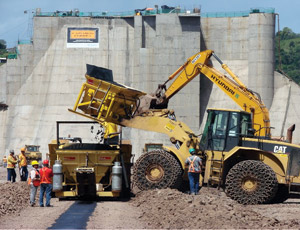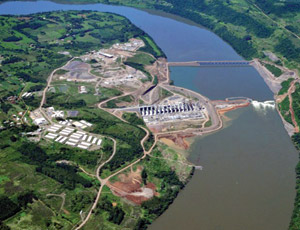Brazil is finalizing construction at its Foz do Chapec� hydroelectric plant. The last phase, a rockfill dam, was completed last April. The project used asphalt instead of clay as the main component of the sealing nucleus—a first in Brazil. The choice of this technique resulted from a number of advantages the contractors and owners of the project researched in Europe.


Asphalt allows for faster construction, even during the rainy season, says Miguel Zerbini, technical director of the consortium in charge of construction, Chapec� Energia. “Conventionally ... rockfill dams [are] sealed with a clay nucleus or concrete face,” he says, “but the asphalt nucleus [made it possible] to meet the schedule.”
Clay can be used only when it is almost fully dry, with a controlled moisture content, according to Zerbini. Asphalt, on the other hand, is an excellent waterproofing agent that can can be used immediately after the rains stop or even during a light shower.
Engineer Helge Saxegaard, director of Kolo Veidekke, the Norwegian company that owns the technology, says that, if the content of voids in the nucleus is smaller than 3%, asphalt acts as a waterproof viscous-elastic-plastic material. It adjusts itself to deformations and pressures that occur during construction and even earthquakes. The material is not prone to shearing strain or volume expansion, characteristics that would increase permeability. Further, asphalt is ideal in regions where clay deposits are scarce.
In Foz do Chapec�, the asphalt nucleus is 55centimeters wide and 47 meters high. The asphalt mass is placed in the dam at temperatures varying from 150� to 170� C. During construction of the 47-m-high and 548-m-long dam, the contractor placed three to four asphalt- concrete layers a day, each approximately 23 cm high.
The contractor Volta Grande Consortium—comprising Construções e Comércio Camargo Corrê (construction), CNEC Engenharia Ltda (design) and Alstom Hydro Energia do Brasil Ltda. (equipment)—set up an automatic asphalt processing plant dedicated to the project. The batch plant was equipped with an emissions filter and two feeding silos. Initially, the contractor placed a 1- to 2-cm-thick mastic asphalt layer between the concrete plinth and the base of the asphalt nucleus. The nucleus is created with a paving machine equipped with an infrared heater that warms up the previous layer to provide adequate fusion.
After the start-up of the hydroelectric plant, the dam will be used as a road linking the counties �guas de Chapec� and Alpestre, providing an alternative route between the states of Santa Catarina and Rio Grande do Sul.
Currently more than 2,000 people are working at the hydroelectric plant’s jobsite, down from the peak workforce of 4,000. The first generating unit is expected to start to operate in August 2010. Located in the Uruguay River, the hydroelectric plant will have an installed capacity of 855 MW power, equivalent to the consumption of 25% of Santa Catarina state and 18% of Rio Grande do Sul state.

Post a comment to this article
Report Abusive Comment